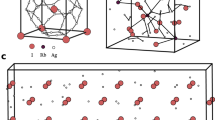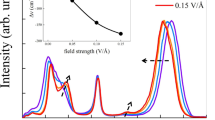Abstract
Electrical image potentials near a metallic or a dielectric wall of higher dielectric constant than that of the solution are attractive, and therefore, could concentrate salt ions near the wall. In fact, ions in room temperature ionic liquids have been observed to precipitate near a metallic surface (but not near a nonmetallic surface). It will be argued that a likely reason for why precipitation of ions in salt water due to electrical image forces has not as yet been observed is that the solvation of the ions is reduced near the wall. This results in an energy barrier. This reduction occurs because of the large decrease near the wall of the dielectric constant of water normal to the wall. The conditions under which ions are able to get past the resulting energy barrier and concentrate at a solid wall, either as a result of a reduction in this barrier due to screening at high ion concentration or as a result of thermal activation over the barrier will be explored.





Similar content being viewed by others
Data availability
The data that supports the findings of this study are available within the article. They are either found in the tables or may be calculated form the equations contained in the article.
References
P.M. Biesheuvel, S. Porada, M. Levi, M.Z. Bazant, J. Solid State Electrochem. 18, 1365–1376 (2014)
J. Comtet, A. Nigues, V. Kaiser, B. Coasne, L. Bocquet, A. Siria, Nat. Mater. 16, 634–639 (2017)
R. Wang, Z.-G. Wang, Phys. Rev. Lett. 112, 136101 (2014)
P. Loche, C. Ayaz, A. Schlaich, D.J. Bonthuis, R.R. Netz, J. Phys. Chem. Lett. 9, 6463 (2018)
R.P. Misra, D. Blankschtein, Langmuir 37, 722 (2021)
D.J. Tobias, A.C. Stern, M.D. Baer, Y. Levin, C.J. Mundy, Annu. Rev. Phys. Chem. 64, 339 (2013)
Y. Levin, A.P. dos Santos, A. Diehl, Phys. Rev. Lett. 103, 257802 (2009)
L. Chen, G. Shi, J. Shen, B. Peng, B. Zhang, Y. Wang, F. Bian, J. Wang, D. Li, Z. Qian, Gang Xu, Gongping Liu, Jianrong Zeng, Lijuan Zhang, Yizhou Yang, Guoquan Zhou, Minghong Wu, Wanqin Jin, Jingye Li, Haiping Fang, Gongping Liu, Jianrong Zeng, Lijuan Zhang, Yizhou Yang, Guoquan Zhou, Minghong Wu, Wanqin Jin, Jingye Li, Haiping Fang, Nature 550, 380–383 (2017)
B. Corry, J. Phys. Chem. B 112, 1427–1434 (2008)
D. Konatham, J. Yu, T. Ho, A. Striolo, Langmuir 29, 11884–11897 (2017)
A. Siria, M.-L. Bocquet, Nat. Rev. Chem. 1, 0091 (2017)
G. Feng, S. Li, V. Presser, P.T. Cummings, J. Phys. Chem. Lett. 4, 3367–3376 (2013)
A.C. Forse, C. Merlet, J.M. Griffin, C.P. Grey, J. Am. Chem. Soc. 138, 5731–5744 (2016)
R. Tabassian, J.-H. Oh, S. Kim, D. Kim, S. Ryu, S.-M. Cho, N. Koratkar, I.-K. Oh, Nat. Commun. 7, 13345 (2016)
J. Yang, C. Calero, M. Bonomi, J. Martí, J. Chem. Theory Comput. 11, 4495–4499 (2015)
L. Onsager, N.N.T. Samaras, J. Chem. Phys. 2, 528–536 (1933)
J.B. Sokoloff, Phys. Rev. E 101, 013110 (2020)
A.W.C. Lau, J.B. Sokoloff, Phys. Reve. E 102, 052606 (2020)
A.H. Castro Neto, F. Guinea, N.M.R. Peres, K.S. Novoselov, A.K. Geim, Rev. Mod. Phys. 81, 109 (2009)
A.A. Kornyshev, A.I. Rubinshtein, M.A. Vorotyntsev, Phys. Stat. Solidi (b) 84, 125 (1977)
A.A. Kornyshev, M.A. Vorotyntsev, J. Phys. C: Solid State Phys. 11, L691 (1978)
L. Fumagalli, A. Esfandiar, R. Fabregas, S. Hu, P. Ares, A. Janardannan, Q. Yang, B. Radha, T. Taniguchi, K. Watanabe, G. Gomila, K.S. Novoselov, A.K. Geim, Science 360, 1339–1342 (2018)
A. Schlaich, E.W. Knapp, R.R. Netz, Phys. Rev. Lett. 117, 048001 (2016)
J.D. Jackson, Classical Electrodynamics (Wiley, New York, 1975)
M. Born, Z. Phys. 1, 45 (1920)
D.J. Bonthuis, S. Gekle, R.R. Netz, Langmuir 28, 7679 (2012)
J.B. Hubbard, L. Onsager, W.M. van Beek, M. Mandel, Proceedings of the National Academy of Science of the United Stats of. America 74, 401 (1977)
R.R. Dogonadze, A.A. Kornyshev, J. Chem. Soc. Faraday Trans. II 70, 1121 (1974)
A.A. Kornyshev, M.A. Vorotyntsev, J. Chem. Soc. Faraday Trans. II 78, 217 (1982)
A.A. Kornyshev, A.G. Volkov, J. Electroanal. Chem. 180, 363 (1984)
M.V. Federov, A.A. Kornyshev, Mol. Phys. 105, 1 (2007)
J.B. Hasted, D.M. Ritson, C.H. Collie, J. Chem. Phys. 16, 1 (1948)
J. Hubbard, L. Onsager, J. Chem. Phys. 67, 4850 (1977)
G.M. Patey, S.L. Carnie, J. Chem. Phys. 78, 5183 (1983)
J.M. Caillol, D. Leveque, J.J. Weis, J. Chem Phys. 85, 6645 (1986)
J.B. Hubbard, P. Colonomos, P.G. Wolynes, J. Chem. Phys. 71, 2652 (1979)
S.A. Adelman, J.-H. Chen, J. Chem. Phys. 70, 4291 (1979)
K. Nortemann, J. Hilland, U. Kaatze, J. Phys. Chem. A 101, 6864 (1997)
F. Stern, Phys. Rev. B 17, 5009 (1978)
S. Nordholm, J. Chem. Phys. Lett. 105, 302 (1984)
D. Horinek, R.R. Netz, Phys. Rev. Lett. 99, 226104 (2007)
L. Bocquet, E. Charlaix, Chem. Soc. Rev. 39, 1073 (2010)
P.L. Flory, Principles of Polymer Chemistry (Cornell University Press, Ithaca, 1953)
M. Rubinstein, R.H. Colby, Polymer Physics (Oxford University Press, Oxford, 2003)
Acknowledgements
I would like to A.W.C. Lau for his suggestions and for many discussions that I had with him during the course of this project.
Author information
Authors and Affiliations
Contributions
JBS is the sole author. All of the work reported in this manuscript was performed by him.
Corresponding author
Appendices
Appendix A
1.1 Solutions of the Poisson–Boltzmann equation at a metallic and a dielectric surface
The potential for a point charge in a medium with a tensor permittivity is the solution to Poisson’s equation in the region \(z> 0\), where there is a tensor permittivity described in Sect. 3 in the paper,
with a point charge Q located at \(\vec {{r}}_{0} =z_{0} \hat{{z}}\), which is Eq. (7) in the main text. The region with \(z< 0\) will be assumed to have a scalar permittivity \(\varepsilon _{2} \). Let us write \(\phi \) in terms of its Fourier transform on the x and y coordinates,
where the solution to the differential equation obtained when Eq. (A2) is substituted in Eq. (A1) is
for \(z>0\), where A is a constant, which satisfies the boundary condition that it vanishes at \(z\rightarrow \infty \) [4, 5, 12]. If the region with \(\hbox {z}< 0\) is metallic, \(\bar{{\phi }}\) satisfies
where \(\kappa _\mathrm{{TF}} \) is the inverse Thomas–Fermi screening length of the metal, whose solution is
where B is a constant and where \(\chi =(q^{2}+\kappa _\mathrm{{TF}}^{2} )^{1/2}\), which satisfies the boundary condition that it vanishes as \(z\rightarrow -\infty \). At the interface at \(z=0\), the above solutions must be continuous (because of the requirement of continuity of the transverse E-field at the interface), giving
Continuity of the component of the displacement or D-field normal to the interface requires that
as \(z\rightarrow 0\), which gives
The solution of Eqs. (A6) and (A8) is
The image potential energy is given by

For small \(z_{0} \) compared to \(\kappa _\mathrm{{TF}}^{-1} \), large q dominates the integral, and hence,
and for large \(z_{0} \) small q dominates the integral, and hence,
Since we have required that \(z_{0} \) be restricted to values greater than a, Eq. (A11b) gives the minimum value of the image potential. The potential minimum, however, more likely occurs at \(z_{0} \approx \kappa _\mathrm{{TF}}^{-1} \) [20, 21], giving a potential minimum of the order of
For a grounded classical metal for which the potential is zero on the interface, for \({z}> 0\),
which also gives
If the material located at \({z}< 0\) is a dielectric, we set \(\kappa _\mathrm{{TF}} =0\).
Appendix B
1.1 A simple derivation of the distribution of salt ions acted on by an electrical image and a solvation potential
The equilibrium distribution of the ions is determined by minimizing the free energy of the solution, which consists of the entropy of mixing and the potential energy of the ions. A common way to treat the entropy of mixing is to divide the volume of the solution into boxes, where each box has a volume \(v_{0} \) of the order of the volume of a water molecule or a salt ion [43, 44].Therefore, the entropy of mixing is given by
where \(n_\mathrm{s} (z),\;n_\mathrm{w} (z)\) are, respectively, the number of salt ions and the number of water molecules located in the plane made up of boxes whose centers are located a distance z from a wall. The Gibbs free energy is given by
where \(G_{0} \) is the part of the Gibbs free energy that does not depend on the distribution of salt ions among the water molecules and \(U_\mathrm{{tot}} (z)\) is the total energy of an ion located in the plane of boxes a distance z from the wall. In the model treated in this paper, it consists of the sum of the image potential and the self-energy of the ion, which for simplicity in this appendix we will choose to be the same for ions of both charges. The salt ion chemical potential is therefore given by
where we have made the assumption that \(n_\mathrm{s} (z)+n_\mathrm{w} (z)\) is constant. (i.e., we are requiring that the solution is incompressible.) The equilibrium condition is

where \(\Delta z\) is the distance between the successive values of z and \(x(z)=n_\mathrm{s} (z)/n_\mathrm{w} (z)\approx v_{0} \rho _{i} (z).\) Substituting this in Eq. (A4) and solving the resulting differential equation, we obtain
i.e., a Boltzmann distribution for the ions. Hence, the total potential acting on the ions alone determines the ions’ spatial distribution.
Rights and permissions
About this article
Cite this article
Sokoloff, J.B. Effects of electrical image potentials and solvation energy on salt ions near a metallic or dielectric wall. Eur. Phys. J. E 44, 122 (2021). https://doi.org/10.1140/epje/s10189-021-00127-5
Received:
Accepted:
Published:
DOI: https://doi.org/10.1140/epje/s10189-021-00127-5




